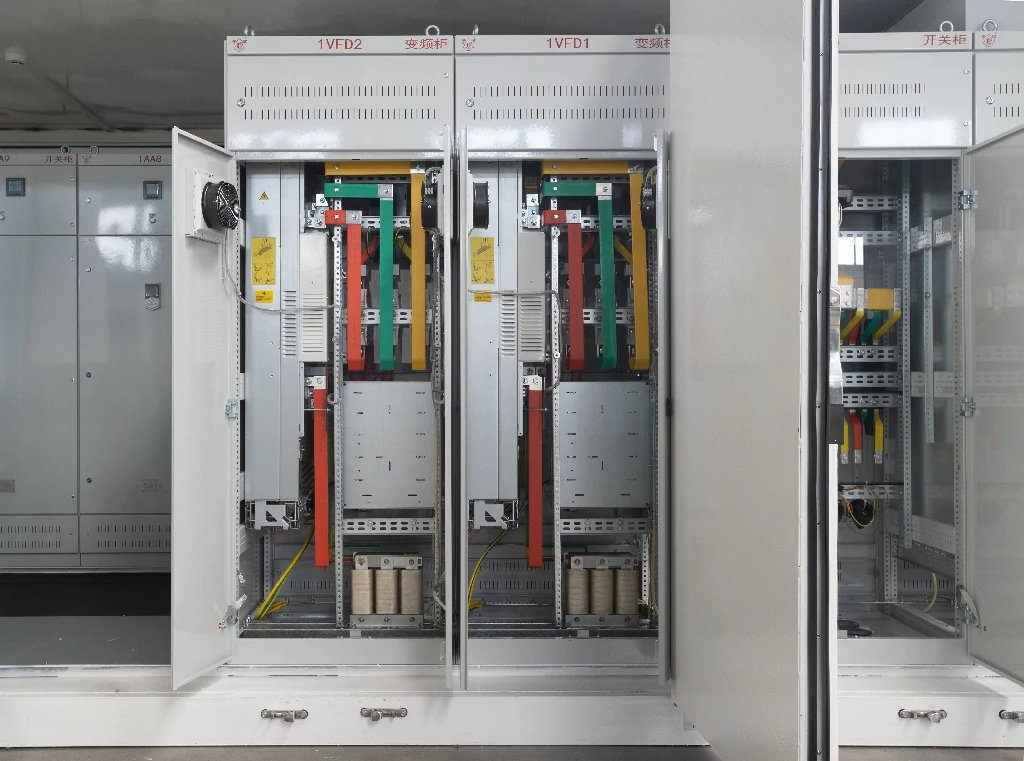Sähkökaappien salvat ovat ratkaisevassa asemassa koteloiden turvallisuuden, toimivuuden ja kestävyyden varmistamisessa. Näiden salpojen materiaalivalinta voi vaikuttaa merkittävästi niiden suorituskykyyn ja pitkäikäisyyteen herkkien sähkökomponenttien suojaamisesta ympäristöhaasteiden kestämiseen. Tässä oppaassa perehdytään syvällisesti sähkökaappien salvoissa käytettäviin eri materiaaleihin ja kerrotaan, miten valita oikea materiaali erityistarpeisiin.
Miksi sähkökaappien salpojen materiaalilla on merkitystä?
Sähkökaappien salvoissa käytetty materiaali vaikuttaa suoraan:
- Suojaus: Estää luvattoman pääsyn ja suojaa arkaluonteisia laitteita.
- Turvallisuus: Vähentää vaaraa altistua vahingossa jännitteisille sähkökomponenteille.
- Ympäristön kestävyys: Varmistaa kestävyyden esimerkiksi korkeassa kosteudessa, kemikaaleille altistumisessa tai äärimmäisissä lämpötiloissa.
Oikean materiaalin valinnalla varmistetaan, että salpa toimii luotettavasti, kestää pidempään ja sopii käyttöympäristöön.
Sähkökaappien salvoissa käytettävät yleiset materiaalit
1. Ruostumaton teräs
Ruostumaton teräs on yksi yleisimmin käytetyistä salpamateriaaleista, koska se kestää korroosiota poikkeuksellisen hyvin ja on yleisesti ottaen kestävä.
- Tärkeimmät ominaisuudet:
- Kestää luonnostaan ruostetta ja korroosiota, jopa merialueilla tai erittäin kosteissa ympäristöissä.
- Korkea lujuus ja sitkeys, ihanteellinen raskaisiin sovelluksiin.
- Tyylikäs ja kiillotettu ulkonäkö moderniin muotoiluun.
- Tyypilliset sovellukset:
- Ulkona käytettävät sähkökotelot (esim. katuvalojen ohjauskotelot).
- ankarat teollisuusympäristöt, kuten kemiantehtaat tai elintarvikkeiden jalostuslaitokset.
- Korkealuokkaiset laitteet, joissa sekä toiminnallisuudella että estetiikalla on merkitystä.
2. Hiiliteräs
Hiiliteräs on taloudellinen vaihtoehto, joka tunnetaan lujuudestaan. Se vaatii kuitenkin suojapinnoitteita korroosion estämiseksi.
- Tärkeimmät ominaisuudet:
- Korkea vetolujuus mekaanisen rasituksen käsittelemiseksi.
- Korroosionkestävyyden vuoksi on oltava sinkitty, pulverimaalattu tai maalattu.
- Kustannustehokas budjettiherkille hankkeille.
- Tyypilliset sovellukset:
- Sisätilojen sähkökaapit.
- Hankkeet, joissa tarvitaan tukevia salpoja edullisemmin kustannuksin.
3. Alumiini
Alumiinia arvostetaan sen keveytensä ja luonnollisen korroosionkestävyytensä vuoksi, minkä vuoksi se on ihanteellinen kannettaviin ja pitkäikäisiin malleihin.
- Tärkeimmät ominaisuudet:
- Kestää luonnostaan ruostetta, erityisesti vähemmän aggressiivisissa ympäristöissä.
- Kevyt ja helppo asentaa.
- Hyvä lämmönjohtavuus, joten se soveltuu lämpötilaherkkiin sovelluksiin.
- Tyypilliset sovellukset:
- Kannettavat tai kevyet sähkökotelot.
- Kaapit, jotka edellyttävät tehokasta lämmönpoistoa.
4. Sinkkiseos
Sinkkiseos on monipuolinen ja kustannustehokas materiaali, joka valitaan usein sen vuoksi, että se voidaan valaa monimutkaisiin muotoihin.
- Tärkeimmät ominaisuudet:
- Muotoillaan helposti monimutkaisiin malleihin, ihanteellinen räätälöityjä salpoja varten.
- Korroosionkestävyyttä parannetaan pinnoittamalla kromilla tai nikkelillä.
- Kestävä ja edullinen yleiskäyttöön.
- Tyypilliset sovellukset:
- Asuin- ja liikesähkökaapit.
- Sisätiloissa tai lievästi ulkona.
5. Messinki
Messinki, kuparin ja sinkin seos, on korroosionkestävyytensä ja viehättävän kultaisen värisävynsä ansiosta sekä käytännöllinen että koristeellinen.
- Tärkeimmät ominaisuudet:
- Kestää luonnostaan himmentymistä ja korroosiota.
- Esteettistä vetovoimaa projekteissa, joissa vaaditaan ensiluokkaista ulkonäköä.
- Ei-magneettiset ominaisuudet, hyödyllisiä erikoissovelluksissa.
- Tyypilliset sovellukset:
- Korkealuokkaiset tai koristeelliset sähkökaapit.
- Kosteusalttiit ympäristöt, kuten merisovellukset.
6. Muovi (polyamidi, ABS)
Muoviset salvat, erityisesti polyamidista tai ABS:stä (akryylinitriilibutadieenistyreenistä) valmistetut salvat, ovat kasvattaneet suosiotaan keveytensä ja eristysominaisuuksiensa vuoksi.
- Tärkeimmät ominaisuudet:
- Johtamaton, mikä takaa sähköturvallisuuden.
- Korroosionkestävä ja huoltovapaa.
- Voidaan vahvistaa lasikuidulla lujuuden lisäämiseksi.
- Tyypilliset sovellukset:
- Kevyet tai ei-teolliset ympäristöt.
- Sisäkotelot pienemmille sähköasennuksille.
Materiaalien vertailu: Mikä sopii sovellukseesi?
Sopivan salpamateriaalin valinta riippuu ympäristöstä ja erityisvaatimuksista:
- Ympäristötekijät:
- Ulkokäyttö: Ruostumaton teräs tai alumiini niiden erinomaisen korroosionkestävyyden vuoksi.
- Sisäkäyttö: Sinkkiseos tai pinnoitettu hiiliteräs ovat kustannustehokkaita vaihtoehtoja.
- Talousarvio:
- Kustannustietoiset hankkeet hyötyvät hiiliteräksestä tai sinkkiseoksesta.
- Korkealuokkaiset sovellukset saattavat vaatia ruostumatonta terästä tai messinkiä.
- Painovaatimukset:
- Kevyissä malleissa voidaan käyttää alumiinia tai vahvistettua muovia.
- Raskaissa teollisuussovelluksissa suositaan ruostumatonta terästä tai hiiliterästä.
Materiaalitekniikan edistysaskeleet
Teknologian kehitys parantaa jatkuvasti sähkökaappien salpamateriaalien suorituskykyä. Tärkeimpiä innovaatioita ovat mm:
- Pintapinnoitteet:
- Sinkitys, jauhemaalaus ja kromaus parantavat korroosionkestävyyttä merkittävästi.
- Sormenjälkiä estävät pinnoitteet parantavat käytettävyyttä ja säilyttävät esteettisyyden.
- Komposiittimateriaalit:
- Metallien ja muovien yhdistäminen luo hybridisalpoja, jotka ovat kevyitä mutta vahvoja.
- Ihanteellinen monitoimisuutta vaativiin malleihin (esim. tärinänkestävyys, itselukittuva).
- Kestävät materiaalit:
- Kierrätysmetallit ja biopohjaiset muovit ovat nousemassa ympäristöystävällisiksi vaihtoehdoiksi.
- Biohajoavia polymeerejä tutkitaan myös kevyempiin sovelluksiin.
FAQ: Sähkökaapin salvan materiaaleja koskevat yleiset kysymykset
1. Mitä materiaaleja käytetään yleisesti salvoissa?
Salvat valmistetaan yleensä metalleista, kuten ruostumattomasta teräksestä, hiiliteräksestä, alumiinista, sinkkiseoksista ja messingistä. Erityissovelluksissa käytetään myös muovia, kuten ABS:ää ja polyamidia.
2. Ovatko muoviset salvat riittävän kestäviä teollisuuskäyttöön?
Nykyaikaiset lujitemuovit, erityisesti lasikuitua sisältävät, kestävät kohtalaisia kuormituksia ja soveltuvat ympäristöihin, joissa tarvitaan kevyitä ja korroosionkestäviä ratkaisuja.
3. Mikä materiaali on paras ulkokäyttöön?
Ruostumaton teräs ja alumiini ovat erinomaisia vaihtoehtoja ulkoympäristöihin, koska ne kestävät ruostetta ja korroosiota.
4. Miten hiiliteräksisistä salvoista voidaan tehdä kestävämpiä?
Suojapinnoitteet, kuten galvanointi tai jauhemaalaus, parantavat merkittävästi hiiliteräksisten salpojen käyttöikää ja korroosionkestävyyttä.
Sähkökaappien salpojen suunnittelun suuntaukset
Salpojen suunnittelun viimeaikaisessa kehityksessä keskitytään toiminnallisuuteen, tehokkuuteen ja kestävyyteen:
- Modulaariset järjestelmät: Vaihdettavat salvan osat mahdollistavat helpon mukauttamisen ja korjaamisen.
- Älykkäät salvat: Elektronisen lukituksen ja kauko-ohjauksen kaltaiset ominaisuudet ovat yleistymässä.
- Ympäristöystävälliset vaihtoehdot: Kierrätettävät metallit ja biopohjaiset muovit ovat linjassa vihreiden tuotantokäytäntöjen kanssa.
Yhteenveto
Sähkökaappien salvat valmistetaan useista eri materiaaleista, joilla kaikilla on omat etunsa. Ruostumaton teräs tarjoaa vertaansa vailla olevaa kestävyyttä ja korroosionkestävyyttä, kun taas alumiini ja messinki ovat erinomaisia kevyissä tai esteettisissä sovelluksissa. Sinkkiseos ja hiiliteräs ovat edullisia, ja muovit ovat ihanteellisia ei-johtaviin ja kevyisiin tarpeisiin. Kun ymmärrät ympäristösi ja käyttökohteesi, voit valita sopivimman materiaalin sähkökaappien luotettavuuden ja pitkäikäisyyden varmistamiseksi.
Jos olet valmis valitsemaan parhaan materiaalin tai tarvitset neuvoja tiettyyn käyttötapaukseen, ota rohkeasti yhteyttä ja kysy asiantuntijan neuvoja!







